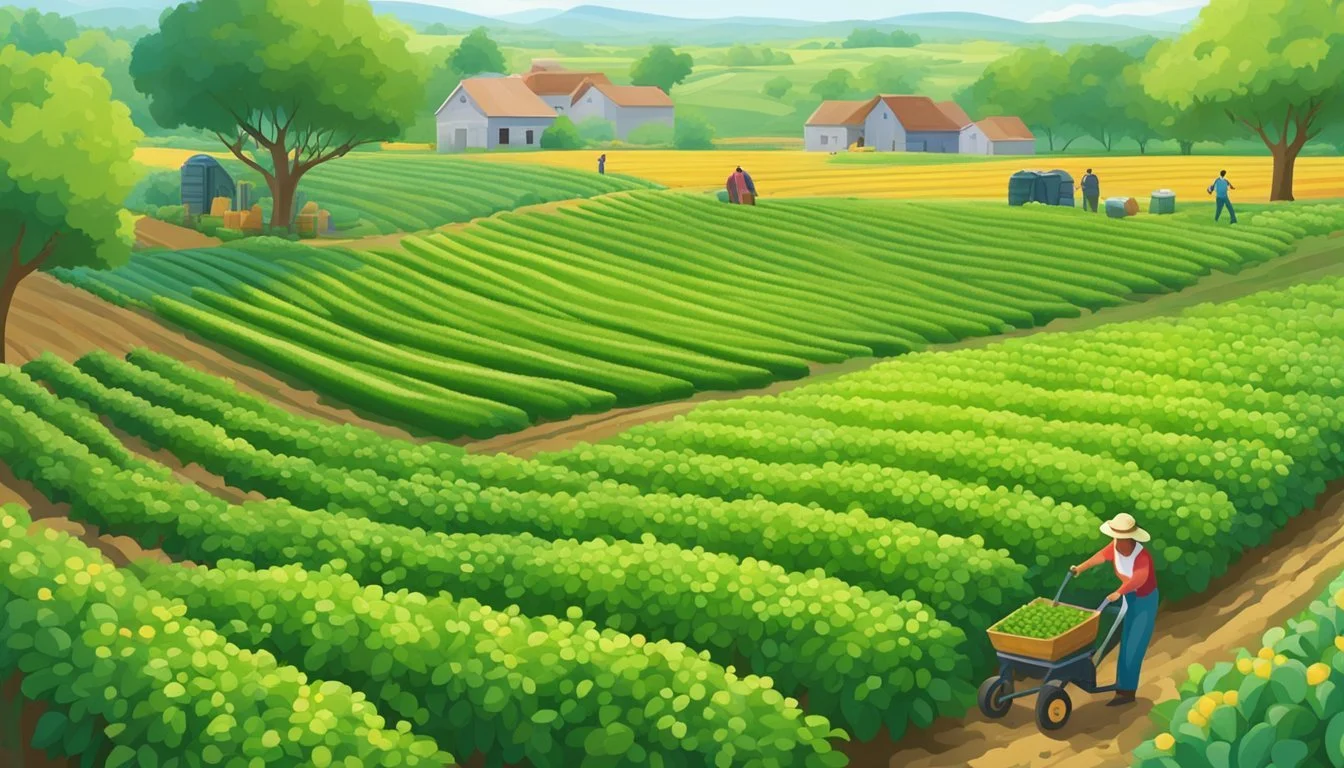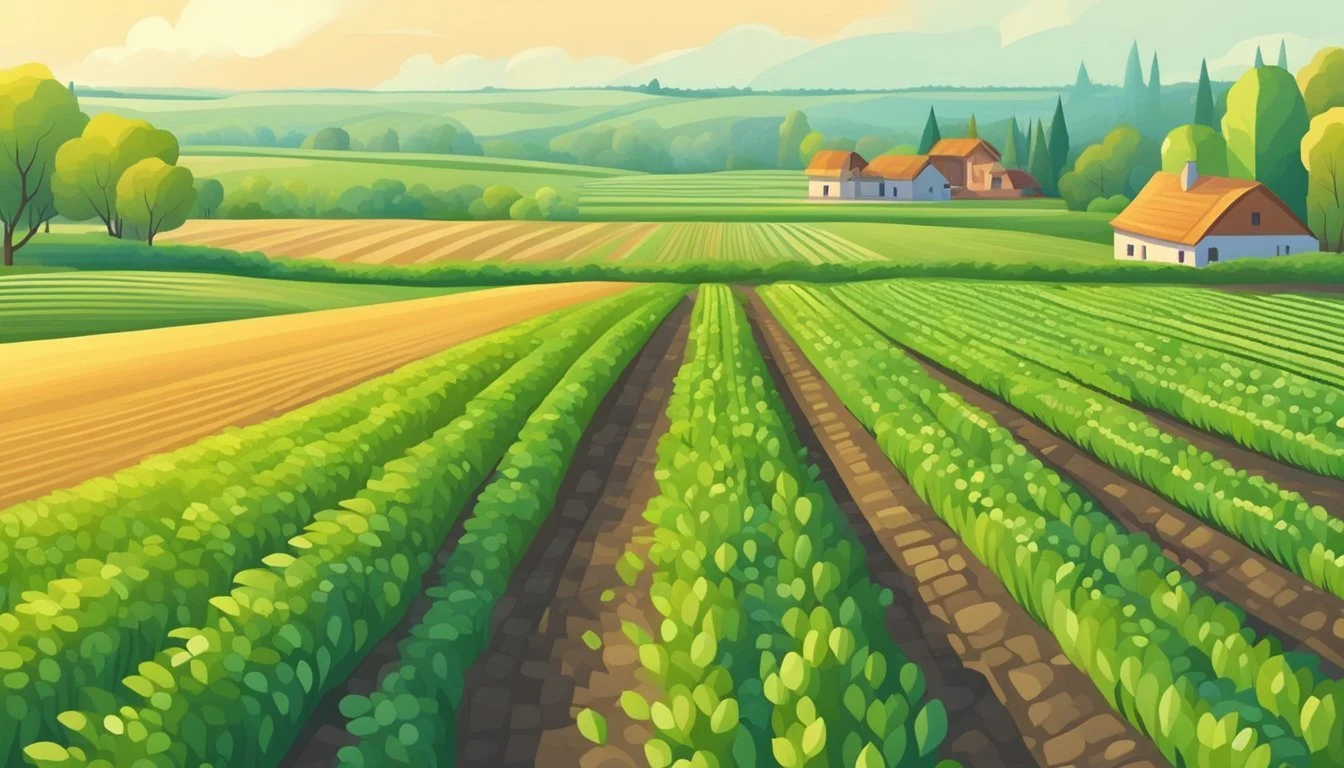Iowa Seasonal Fruit & Vegetables in March
A Guide to Fresh Produce
This Article is Part of our Iowa Seasonal Fruit & Veg Calendar
As March arrives, it brings a transitional period to Iowa's agricultural canvas, one that slowly awakens from winter's slumber. This time of year, locals and food enthusiasts eagerly anticipate the arrival of fresh, seasonal produce. In Iowa, the seasonal cycle dictates the availability of fresh fruits and vegetables, making March a time when certain crops begin to thrive, while others reach the end of their winter availability.
Seasonal produce in Iowa during March can vary due to weather conditions and geographical difference across the state, but some fruits and vegetables begin to show signs of emergence. While the remnants of hearty winter staples might still be found, the onset of milder weather allows for the ground to prepare for new plantings. Consumers looking for fresh and seasonal options can often find local produce that is harvested at its peak for flavor and nutrition.
Shopping for seasonal produce not only supports Iowa's local farmers and economy, it also increases the ecological sustainability of food consumption, reducing the carbon footprint associated with long-distance transportation of out-of-season imports. March in Iowa is a period where the embrace of seasonal consumption is not only a testament to local culinary tradition but also a step towards a more sustainable lifestyle.
Availability of Seasonal Produce in March
March in Iowa marks the transitional period from winter to spring, bringing a shift in available produce. This month's seasonal offerings include a variety of vegetables and fruits that provide freshness and flavor to local cuisine.
Vegetables Available in March
Root Vegetables:
Potatoes
Carrots
Beets
Leafy Greens:
Spinach (What wine goes well with spinach?)
Kale
Collard greens (how long do collard greens last?)
Assorted Vegetables:
Lettuce
Radishes
Fruits Available in March
March is not peak season for fruit in Iowa; however, consumers can usually find stored apples from the previous fall harvest as well as greenhouse-grown strawberries.
Benefits of Eating Seasonal Produce
Eating seasonal produce during March in Iowa offers multiple advantages, from heightened nutrient content to positive environmental effects and economic savings.
Nutritional Advantage
Seasonal fruits and vegetables harvested at their peak in Iowa often have optimal nutrient levels. For example, asparagus, abundant in March, provides an excellent source of fiber, folate, and vitamins A, C, and K. Fresh produce that doesn't have to travel long distances typically retains more vitamins and minerals, ensuring a more nutritious diet. Seasonal produce also encourages a diverse intake of nutrients as different fruits and vegetables become available throughout the year.
Environmental Impact
Consuming seasonal produce lowers the environmental impact of food consumption. Local fruits and vegetables require less transportation and therefore contribute to reduced carbon emissions. Moreover, seasonal farming practices can be more organic, as they often align more closely with natural growing conditions, minimizing the need for chemical pesticides and fertilizers. This leads to a more sustainable agricultural practice and a smaller carbon footprint.
Economic Benefits
Purchasing seasonal produce can lead to significant economic benefits. The abundance of in-season produce generally drives down costs, offering consumers higher quality food for better prices. Additionally, buying local supports Iowa's economy and builds community by funneling consumer spending back to regional farmers. This financial cycle encourages a resilient local food system and economic growth within the community.
Selection and Storage Tips
When selecting and storing seasonal fruits and vegetables in Iowa during March, one should focus on indicators of freshness and appropriate storage methods to extend shelf life and maintain quality. Knowledge of individual characteristics for both fruits and vegetables is crucial for optimal storage.
Choosing the Freshest Produce
Freshness is key when selecting produce. Vegetables should be firm and vibrant in color, with no signs of wilting or damage. For fruits, look for those that are slightly firm, but give a little under gentle pressure, indicating ripeness without over-softness. It's also vital to assess the smell — ripe fruits often have a noticeable but not overpowering fragrance.
Storing Vegetables
Each vegetable has its own ideal storage conditions which should be adhered to for maintaining freshness. For instance, leafy greens should be stored in the refrigerator and consumed within a week of purchase. They can be kept in open produce bags to retain moisture yet allow breathing room. Root vegetables, like beets and carrots, should be stored in a cool, dark place and can last much longer.
Storing Fruits
Fruits generally have a shorter shelf life and should be consumed quicker than most vegetables. Citrus fruits and apples may last longer and can be kept on a countertop for a few days or refrigerated to extend their freshness. Berries tend to deteriorate faster and should be consumed within days of purchase; they should be refrigerated and kept in their original container or a paper towel-lined bowl for absorption of any excess moisture.
Freezing Tips
Freezing can greatly extend the life of both fruits and vegetables while preserving most of their nutritional value. For the freshest possible outcome, fruits and vegetables should be washed, dried, and cut as needed before freezing. Blot dry with a towel to prevent ice crystals from forming. Vegetables are best when blanched prior to freezing to preserve color, texture, and flavor. Fruits can be frozen raw, and those prone to browning like apples or pears can be tossed with lemon juice beforehand. Use freezer bags or airtight containers and try to remove as much air as possible before sealing.
Preparing Seasonal Produce
When preparing seasonal produce in Iowa during March, the freshness of fruits and vegetables is paramount for taste and nutrition. They can be enjoyed raw or cooked, with each method enhancing different flavors and textures.
Cooking Methods for Vegetables
Vegetables harvested in March such as spinach, kale, and radishes, provide optimal nutrition and flavor when fresh. Here are cooking methods that retain their integrity:
Steaming: Ideal for greens like spinach; it maintains their color and nutritional value.
Roasting: Enhances the natural sweetness of root vegetables.
Sautéing: Quick and versatile for tender vegetables like kale.
Cooking Methods for Fruits
Fruits available in March in Iowa, such as apples stored from the fall season, can be prepared using various techniques:
Raw: Apples are crisp and refreshing when eaten raw.
Baking: Apples can be baked into desserts like pies or crisps.
Poaching: Poaching can bring out a soft texture and subtle flavors.
Recipe Ideas
Creating dishes with March’s produce in Iowa encourages the use of fresh ingredients in simple yet delicious recipes:
Raw Vegetable Salad: Combine spinach and thinly sliced radishes with a vinaigrette.
Roasted Root Vegetables: Toss carrots and turnips with olive oil, salt, and pepper, then roast until tender.
Apple Crisp: Layer sliced apples with cinnamon and an oat-based topping, baking until golden and bubbly.
Seasonal Activities in Iowa
March in Iowa ignites a resurgence in agriculture and community activities. As the ground thaws, residents and visitors alike take part in various events that celebrate the upcoming planting season and the last of winter’s bounty.
Local Farmers' Markets
Farmers' markets in Iowa start to welcome visitors, offering the last of winter produce as well as early spring items. These markets are a hub for fresh, local produce and provide a platform for farmers to sell directly to consumers. Attendees can expect to find items such as root vegetables and greenhouse-grown greens.
U-Pick Farms
This time of year, U-pick farms start preparing for the season. While it’s still early for many fruits and vegetables, some farms may offer U-pick for greenhouse-grown produce or plan events like corn mazes from the prior fall that are still operational. These farms offer a hands-on experience for families and individuals to select their produce directly from the source.
Agricultural Festivals
Iowa's agricultural festivals in March are an educational and celebratory affair. They mark the transition from winter to spring and highlight the state's agricultural heritage. Festivals may feature seasonal activities like seed planting workshops, discussions about sustainable farming, and the promotion of fresh, local produce.
Agricultural Practices in Iowa
Iowa's agricultural sector employs various techniques to ensure the production of high-quality fruits and vegetables, with a particular focus on organic farming and effective pest and disease management.
Organic Farming Techniques
Organic farmers in Iowa adopt sustainable practices to maintain soil fertility and ecological balance, eschewing synthetic fertilizers and pesticides. They rely on crop rotation, green manures, and compost to nurture soil health. Cover cropping is another pivotal technique; it suppresses weeds, prevents soil erosion, and enhances soil moisture.
Soil Health: Use of natural compost and green manures.
Weed Control: Employing mechanical tillage and manual weeding.
Crop Diversity: Rotation of multiple species for resilience.
Pest and Disease Management
Iowa's farmers implement integrated pest management (IPM) strategies to control pests and diseases, minimizing harm to the environment.
Biological Control: Introduction of natural predators to manage pest populations.
Cultural Practices: Crop rotation to break pest and disease life cycles.
Physical Barriers: Use of netting and traps to protect crops from pests.
Monitoring crops for early detection of issues is a key aspect of these strategies, ensuring that interventions are timely and effective.
Understanding Seasonal Cycles
Understanding the seasonal cycles of produce is crucial for both consumers and agricultural producers. Knowing when fruits and vegetables are in peak season can ensure the freshest and most flavorful produce, as well as potentially lower prices due to abundance.
Seasonality of Produce
Certain fruits and vegetables thrive in different seasons in Iowa. Summer crops include sweet corn, tomatoes, and peppers, which are often harvested starting in late June until September. In contrast, fall brings a new variety of produce such as apples and pumpkins, beginning around late August and extending through November. Winter does not provide the same wealth of fresh produce due to the colder climate; however, some hearty vegetables like squash are stored and used throughout the season.
Season Common Produce Summer Sweet corn, tomatoes, peppers Fall Apples, pumpkins Winter Squash
Impact of Weather on Crop Yield
Iowa's weather can significantly impact the yield and quality of its crops. A mild and wet spring may promote early planting and growth, leading to a bountiful early summer harvest. However, an overly harsh winter or unseasonably frosty spring could delay planting times and decrease yields. Additionally, severe weather events like droughts or floods during critical growth periods can devastate crops, thus affecting their seasonality and availability. While growers have made advancements in mitigating weather impacts through technology and innovative practices, they remain subject to nature's unpredictability.








